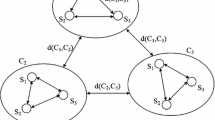Abstract
The increasing use of hand-held devices which have access to location information, has raised the risk of privacy disclosure. To implement privacy protection on the locations with plenty of check-ins, this thesis proposes a novel location perturbation method based on geo-indistinguishability, which has less quality loss and high privacy guarantee. In order to tackle the problem of how to preserve each person’s frequently occurring position points, we reformulate this issue with a three-step framework. First, the location set is classified by the density-based clustering algorithm, and the privacy budget allocation function is used to allocate the corresponding budget for each cluster. Second, the real location is disturbed according to geo-indistinguishability, and the spanner structure is introduced to increase the efficiency of noise addition and the availability of location data. Finally, we present a privacy metric approach derived from the information entropy to quantify the information leakage by the mechanism, which provides the basis for the analysis of information loss. The experiments are carried out in two real datasets: GeoLife and Taxi GPS reports. Our evaluation confirms that the performance of the proposed strategy is superior to the state-of-the-art solutions in terms of quality loss and privacy metric.








Similar content being viewed by others
References
Althöfer I, Das G, Dobkin D, Joseph D, Soares J (1993) On sparse spanners of weighted graphs. Discrete Comput Geom 9(1):81–100
Andrés M E, Bordenabe N E, Chatzikokolakis K, et al (2013) Geo-indistinguishability: Differential privacy for location-based systems. Proceedings of the 2013 ACM SIGSAC conference on Computer & communications security. pp. 901–914.
Beimel A, Nissim K, Stemmer U (2013) Private learning and sanitization: pure vs. approximate differential privacy. Approximation, randomization, and combinatorial optimization. Algorithms and techniques. Springer, Berlin, Heidelberg, pp. 363-378.
Bordenabe N E (2014) Measuring privacy with distinguishability metrics: definitions, mechanisms and application to location privacy. Dissertation, École Polytechnique, Palaiseau, France.
Bordenabe N E, Chatzikokolakis K, Palamidessi C (2014) Optimal geo-indistinguishable mechanisms for location privacy. Proceedings of the 2014 ACM SIGSAC conference on computer and communications security. pp. 251–262.
Chatzikokolakis K, Palamidessi C, Stronati M (2014) A predictive differentially-private mechanism for mobility traces. International Symposium on Privacy Enhancing Technologies Symposium. Springer, Cham, pp. 21–41.
Chatzikokolakis K, Palamidessi C, Stronati M (2015) Location privacy via geo-indistinguishability. ACM SIGLOG News 2(3):46–69
Chatzikokolakis K, Palamidessi C, Stronati M (2015) Geo-indistinguishability: a principled approach to location privacy. International Conference on Distributed Computing and Internet Technology. Springer, Cham, pp. 49–72.
Chatzikokolakis K, Palamidessi C, Stronati M (2015) Constructing elastic distinguishability metrics for location privacy. Proc Privacy Enhancing Technol 2015(2):156–170
Cover T, Thomas J, Wiley J (2003) Elements of information theory. Tsinghua University Pres, pp. 7-16.
Dewri R (2012) Local differential perturbations: location privacy under approximate knowledge attackers. IEEE Trans Mob Comput 12(12):2360–2372
Dwork C (2006) Differential privacy. Proceeding of the 33nd international conference on automata. Languages and Programming, Springer, pp 1–12
Dwork C, Kenthapadi K, McSherry F, et al (2006) Our data, ourselves: privacy via distributed noise generation. Annual International Conference on the Theory and Applications of Cryptographic Techniques. Springer, Berlin, Heidelberg, pp. 486–503.
GeoLife. https://www.microsoft.com/en-us/research/publication/geolife-gps-trajectory-dataset-user-guide/.
Gudmundsson J, Narasimhan G, Smid M (2016) Geometric spanners. In: Kao MY (ed) Encyclopedia of algorithms. Springer, New York, NY. https://doi.org/10.1007/978-1-4939-2864-4_167
Ho SS, Ruan S (2011) Differential privacy for location pattern mining. Proceedings of the 4th ACM SIGSPATIAL international workshop on security and privacy in GIS and LBS. pp. 17-24.
Hua J, Tong W, Xu F et al (2017) A geo-indistinguishable location perturbation mechanism for location-based services supporting frequent queries. IEEE Trans Inf Forensics Secur 13(5):1155–1168
Ngo H, Kim J (2015) Location privacy via differential private perturbation of cloaking area. 2015 IEEE 28th computer security foundations symposium. IEEE, pp. 63-74.
Shokri R, Theodorakopoulos G, Le Boudec J Y, et al (2011) Quantifying location privacy. 2011 IEEE symposium on security and privacy. IEEE, pp. 247-262.
Shokri R, Theodorakopoulos G, Troncoso C, et al (2012) Protecting location privacy: optimal strategy against localization attacks. Proceedings of the 2012 ACM conference on computer and communications security. Pp. 617-627.
Taxi GPS reports. https://www.cse.ust.hk/scrg/.
Wang D, Long S (2019) Boosting the accuracy of differentially private in weighted social networks. Multimed Tools Appl 78(24):34801–34817
Xiong P, Zhu T, Niu W, Li G (2016) A differentially private algorithm for location data release. Knowl Inf Syst 47(3):647–669
Yin C, Xi J, Sun R et al (2017) Location privacy protection based on differential privacy strategy for big data in industrial internet of things. IEEE Trans Ind Inf 14(8):3628–3636
Zhu T, Li G, Zhou W, et al (2017) Differential privacy and applications. Cham, Switzerland, pp. 151–157.
Acknowledgements
This work is supported by the National Natural Science Foundation of China (NO.62062020)(NO.62002081)(NO.62002080), the Major Scientific and Technological Special Project of Guizhou Province (Grant NO.20183001), Great appreciation goes to the editorial board and the reviewers of this paper.
Author information
Authors and Affiliations
Corresponding author
Additional information
Publisher’s note
Springer Nature remains neutral with regard to jurisdictional claims in published maps and institutional affiliations.
Rights and permissions
About this article
Cite this article
Luo, H., Zhang, H., Long, S. et al. Enhancing frequent location privacy-preserving strategy based on geo-Indistinguishability. Multimed Tools Appl 80, 21823–21841 (2021). https://doi.org/10.1007/s11042-021-10789-0
Received:
Revised:
Accepted:
Published:
Issue Date:
DOI: https://doi.org/10.1007/s11042-021-10789-0




